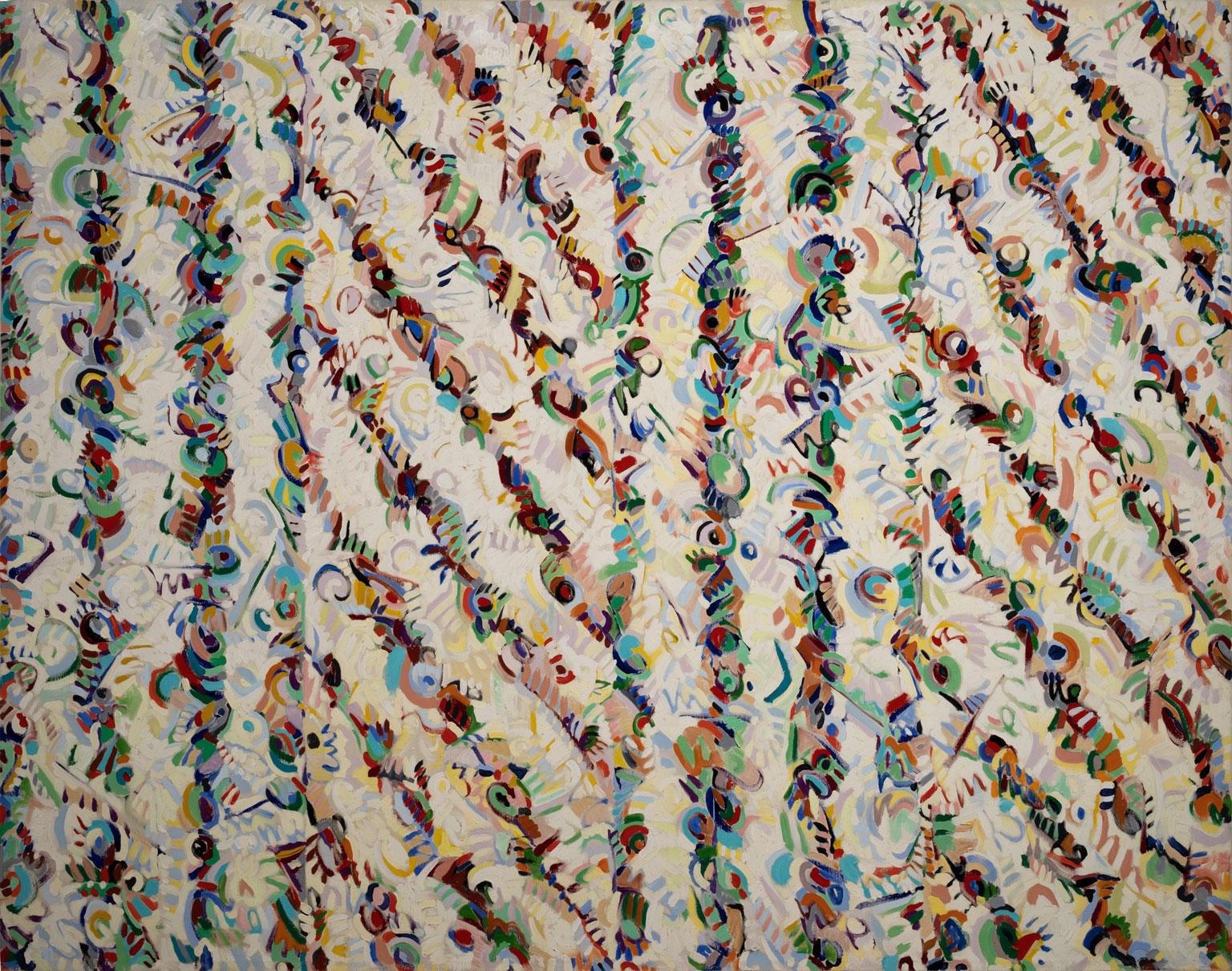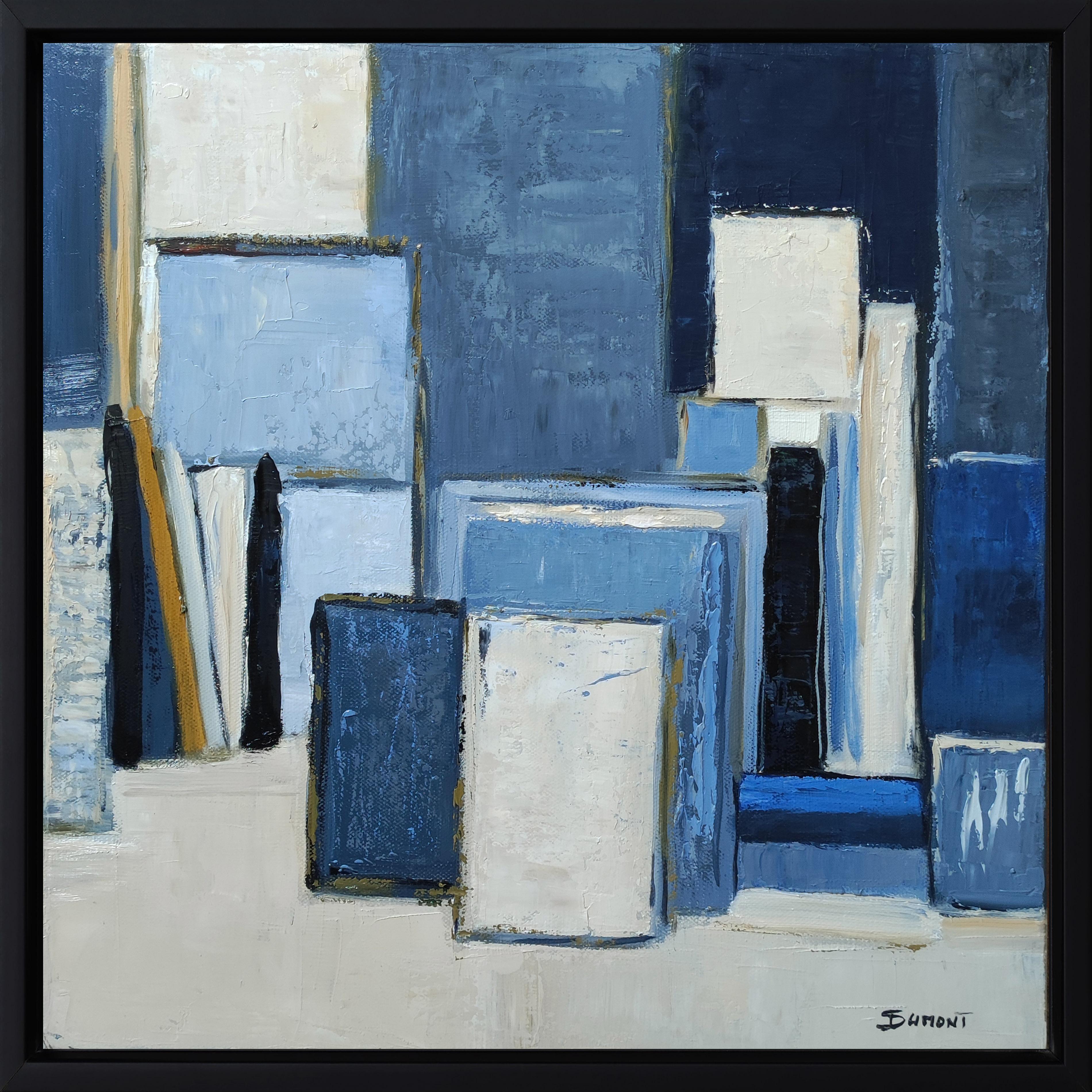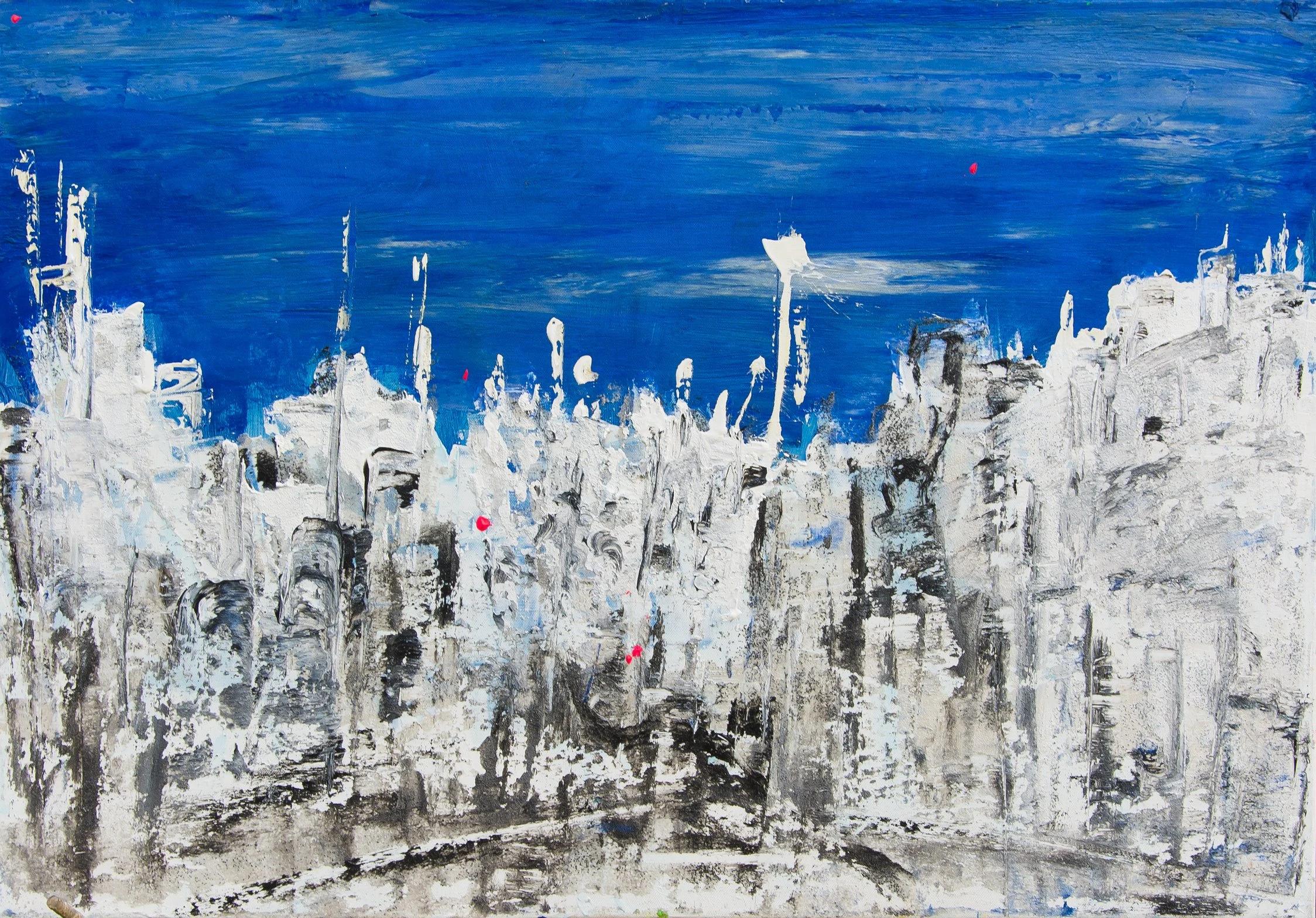Items Similar to "Mirage" Abstract Postwar Oil & marble powder on canvas
Want more images or videos?
Request additional images or videos from the seller
1 of 9
Miyawaki Aiko"Mirage" Abstract Postwar Oil & marble powder on canvas1964
1964
About the Item
Aiko MIYAWAKI graduated from Japan Women's University (Western History Department) in 1952. In 1953, she was introduced to the Western-style painter Nobuya Abe, who taught her the art of Europe and America. From there, she was introduced to artist Yoshishige Saito, who encouraged her to show her art. In 1957, she left to study painting at the University of California and Santa Monica Municipal College. In 1959, she moved to Milan, where she met Enrico Baj, who became her artistic guarantor. She also befriended other great masters of the Italian avant-garde - Lucio Fontana, Enrico Castellani and Piero Manzoni.
Around this time, Miyawaki developed an innovative series in which enamel and marble powder - once mixed with paint - is applied directly to the canvas to create textured and sometimes patterned surfaces. These surfaces, "like dunes", express, in the words of historians, a "tension between transformations and something that remains unchanging". In December 1959, these works were exhibited for the first time at Tokyo's Yoseido Gallery. The artist followed this up in 1961 with another exhibition at Milan's Galleria Minima.
In 1962, another exhibition was held at the Tokyo Gallery. Her paintings attracted the attention of André Schoeller, a French art dealer visiting Japan. Immediately afterwards, the artist signed a contract with Schoeller and moved to Paris to produce her art, which was exhibited there. Miyawaki also met Man Ray, who became her friend and mentor. In 1963, the artist moved to New York, where she had an exhibition in 1964 at the Berta Schaefer Gallery (with Man Ray as foreword to the catalog). Returning to Japan in 1966, the artist gave up painting to take up sculpture. She began by using brass pipes, square steel tubes and copper cylinders - "essentially to investigate movement, the effect of light and the relationship to space".
Miyawaki will develop an innovative series in which enamel and marble powder - once mixed with paint - is applied directly to the canvas to create textured and sometimes patterned surfaces. These surfaces, "like dunes", express, in the words of historians, a "tension between transformations and something that remains unchanging". In December 1959, these works were exhibited for the first time at Tokyo's Yoseido Gallery. The artist followed this up in 1961 with another exhibition at Milan's Galleria Minima. In 1962, another exhibition was held at the Tokyo Gallery. Her paintings attracted the attention of André Schoeller, a French art dealer visiting Japan. Immediately afterwards, the artist signed a contract with Schoeller and moved to Paris to produce his art, which was exhibited there.
Miyawaki also met Man Ray, who became his friend and mentor. In 1963, the artist moved to New York, where she had an exhibition in 1964 at the Berta Schaefer Gallery (with Man Ray as foreword to the catalog). Returning to Japan in 1966, the artist gave up painting to take up sculpture. She began by using brass pipes, square steel tubes and copper cylinders - "essentially to investigate movement, the effect of light and the relationship to space". Her work was immediately exhibited at the Guggenheim Museum in New York, where she received a Purchase Award. This was followed by an exhibition at the Matsuya department store in Tokyo - where she met architect Arata Isozaki (Pritzker Prize 2019), whom she married for the second time in 1972.
Among his sculptures, it is his dynamic, large-scale series from the late 1970s - Utsurohi - that will be best known. Here, the artist seeks to achieve a form that excludes any sculptural weight, using stainless steel piano wire as the material. Here, she would mount thin, swirling metal rods on one or more bases, creating a sensation of movement on the installation site. These sculptures - in perfect dialogue with all the elements of nature - subtly manage to change form, echoing the Japanese concept of Utsuroi ("rapid or ephemeral change"). Miyawaki's monumental Utsuhori work will be dedicated and exhibited outdoors in numerous museums and institutions: Gunma Museum of Modern Art (Takasaki), Nagi Museum of Contemporary Art (Okayama), Museum of Modern Art (Kamakura & Hayama), Parvis de La Défense - Musée des Arts Décoratifs du Palais du Louvre (Paris), Palais des Sports Sant Jordi - Montjuic Olympic Plaza - Fundacio Miro (Barcelona), and Pitman Sculpture Garden (Houston). Miyawaki was honored for her innovation in contemporary Japanese art by the Japan Arts Foundation, and in 2003 (among many other awards and decorations) received the Ordre des Arts et des Lettres from the French Ministry of Culture.
- Creator:Miyawaki Aiko (1929 - 2014, Japanese)
- Creation Year:1964
- Dimensions:Height: 21.26 in (54 cm)Width: 21.26 in (54 cm)
- Medium:
- Movement & Style:
- Period:
- Condition:
- Gallery Location:PARIS, FR
- Reference Number:1stDibs: LU2572212720522
About the Seller
No Reviews Yet
Vetted Seller
These experienced sellers undergo a comprehensive evaluation by our team of in-house experts.
1stDibs seller since 2023
- ShippingRetrieving quote...Ships From: Paris, France
- Return PolicyA return for this item may be initiated within 7 days of delivery.
More From This SellerView All
- Sans titre by Kimura Chuta, Abstract Impressionism, New School of ParisLocated in PARIS, FRChuta KIMURA (also "Tchuta" or "Tshuta") is an allusive landscape painter and pastellist. His name - composed of the words Ki (tree) and Mura (village) -...Category
1980s Abstract Landscape Paintings
MaterialsOil
- View of the Seine River in Corbeil by Kimura Chuta from the New School of ParisLocated in PARIS, FRChuta KIMURA (also "Tchuta" or "Tshuta") is an allusive landscape painter and pastellist. His name - composed of the words Ki (tree) and Mura (village) - literally means "village tree". The artist was born into a middle-class family with an ancestral Samurai background. From the age of 13, he took drawing lessons at the Takamatsu School of Decorative Arts. In 1936, he went on to study at Tokyo's Nika Art Academy, where the academic teaching did not suit him. In 1937, he exhibited for the 1st time at the Dokuritsu Salon, but was immediately drafted by the army to serve in China - where, despite the war, he developed a passion for ancient calligraphy. In 1940, he eventually returned to Japan due to illness. Shortly afterwards, in 1941, he discovered a painting by Pierre Bonnard at the Ohara Art Museum in Kurashiki, the light of which overwhelmed him. He was mobilized again in China in 1945, then, once the war was over, he resumed his exhibitions in Tokyo and discovered Bonnard once again. In 1947, he married Satchiko Yunoki, with whom he decided to move to Paris. Thanks to a patron, the young couple settled in Montparnasse in March 1953 (taking over the former studio of his illustrious compatriot, Foujita). In 1954, he exhibited at the Salon des Artistes Français and met Jacques Zeitoun, artistic director of the "Art Vivant" gallery (Paris and Lyon), who immediately signed him up. From 1955 onwards, Kimura enjoyed a steady stream of solo exhibitions - in Paris (e.g. Galerie St Placide, Kriegel, or Art Yomiuri - the latter exhibiting his work 4 times at FIAC in the 1980s); Lyon (e.g. Galerie St Georges); Antibes (e.g. Galerie St Georges); and Paris. galerie St Georges); Antibes (ex. galerie René Raporte); Brussels (ex. galerie de France et du Benelux); Geneva (ex. galerie Krugier); Tokyo (ex. galleries Nichido, or Takarashi); and New York (ex. galleries David Findlay, or Ruth Sigel). The artist also participated in fairs and group exhibitions (e.g. Biennale de Paris in 1957, Centre Pompidou in 1979, The Phillips Collection in 1985). In 1962, he moved to Châtenay-Malabry and met Jean Grenier - professor of philosophy and holder of the chair of aesthetics and art science at the Sorbonne - who became his principal biographer: "When Kimura rightly prides himself on uniting East and West, which, he writes, are as different from each other as day and night are from each other, he might add that it is by remaining himself and drawing on the dual traditions of his country that he has succeeded in creating a work that is at once so violent and so gentle. In 1963, the French State bought a painting from him - "Jardin à Châtenay". In 1965, Galerie Kriegel (recently opened by his 1st dealer...Category
1960s Abstract Abstract Paintings
MaterialsOil
- Chevalier by Toshimitsu Imai, Abstract, Art Informel MovementBy Toshimitsu ImaiLocated in PARIS, FRToshimitsu Imai (1928-2002) emerges as a remarkable figure in the postwar Japanese avant-garde art scene. Renowned for his abstract paintings, Imai's artistic trajectory defied conve...Category
1960s Abstract Abstract Paintings
MaterialsOil
- Landscape by Kimura Chuta, Abstract Impressionism, New School of ParisLocated in PARIS, FRChuta KIMURA (also "Tchuta" or "Tshuta") is an allusive landscape painter and pastellist. His name - composed of the words Ki (tree) and Mura (village) - literally means "village tree". The artist was born into a middle-class family with an ancestral Samurai background. From the age of 13, he took drawing lessons at the Takamatsu School of Decorative Arts. In 1936, he went on to study at Tokyo's Nika Art Academy, where the academic teaching did not suit him. In 1937, he exhibited for the 1st time at the Dokuritsu Salon, but was immediately drafted by the army to serve in China - where, despite the war, he developed a passion for ancient calligraphy. In 1940, he eventually returned to Japan due to illness. Shortly afterwards, in 1941, he discovered a painting by Pierre Bonnard at the Ohara Art Museum in Kurashiki, the light of which overwhelmed him. He was mobilized again in China in 1945, then, once the war was over, he resumed his exhibitions in Tokyo and discovered Bonnard once again. In 1947, he married Satchiko Yunoki, with whom he decided to move to Paris. Thanks to a patron, the young couple settled in Montparnasse in March 1953 (taking over the former studio of his illustrious compatriot, Foujita). In 1954, he exhibited at the Salon des Artistes Français and met Jacques Zeitoun, artistic director of the "Art Vivant" gallery (Paris and Lyon), who immediately signed him up. From 1955 onwards, Kimura enjoyed a steady stream of solo exhibitions - in Paris (e.g. Galerie St Placide, Kriegel, or Art Yomiuri - the latter exhibiting his work 4 times at FIAC in the 1980s); Lyon (e.g. Galerie St Georges); Antibes (e.g. Galerie St Georges); and Paris. galerie St Georges); Antibes (ex. galerie René Raporte); Brussels (ex. galerie de France et du Benelux); Geneva (ex. galerie Krugier); Tokyo (ex. galleries Nichido, or Takarashi); and New York (ex. galleries David Findlay, or Ruth Sigel). The artist also participated in fairs and group exhibitions (e.g. Biennale de Paris in 1957, Centre Pompidou in 1979, The Phillips Collection in 1985). In 1962, he moved to Châtenay-Malabry and met Jean Grenier - professor of philosophy and holder of the chair of aesthetics and art science at the Sorbonne - who became his principal biographer: "When Kimura rightly prides himself on uniting East and West, which, he writes, are as different from each other as day and night are from each other, he might add that it is by remaining himself and drawing on the dual traditions of his country that he has succeeded in creating a work that is at once so violent and so gentle. In 1963, the French State bought a painting from him - "Jardin à Châtenay". In 1965, Galerie Kriegel (recently opened by his 1st dealer...Category
1970s Abstract Abstract Paintings
MaterialsOil
- "Work" Abstract Postwar Avant-Garde, Oil on canvasLocated in PARIS, FRAiko MIYAWAKI graduated from Japan Women's University (Western History Department) in 1952. In 1953, she was introduced to the Western-style painter Nob...Category
Mid-20th Century Abstract Abstract Paintings
MaterialsOil
- "Work" Abstract Postwar Avant-Garde, Oil & marble powder on canvasLocated in PARIS, FRAiko Miyawaki's 1960 painting stands as a rare and high-quality piece, distinguished by its unique composition and historical significance. Hailing from a private Japanese collection...Category
Mid-20th Century Abstract Abstract Paintings
MaterialsMarble
You May Also Like
- Massive 7-Foot Abstract Oil Painting on Canvas by Ed Gilliam, Frameless DisplayBy Ed GilliamLocated in Encino, CAUntitled Abstract, an original oil on canvas by Edward Gilliam, is a piece for the true collector. Gilliam's use of color and paint thickness immediately captivates the viewer. It is...Category
1980s Abstract Abstract Paintings
MaterialsOil
- atelier bleu, abstract, oil on canvas, contemporary, expressionism, french artBy SOPHIE DUMONTLocated in LANGRUNE-SUR-MER, FRArtist's studio in a dominant blue with a texture very present and colors that vibrate with the succession of layers on the canvas. Cubic shapes, parallel and perpendicular lines, wi...Category
21st Century and Contemporary Abstract Geometric Abstract Paintings
MaterialsOil
- "Shimmering Skyline II" Abstract Painting 27.5" x 39" inch by Ahmed FaridBy Ahmed FaridLocated in Culver City, CA"Shimmering Skyline II" Abstract Painting 27.5" x 39" inch by Ahmed Farid Born in Cairo, Egypt, in 1950 where he currently lives and works, Farid is an autodidact Egyptian painters...Category
21st Century and Contemporary Abstract Abstract Paintings
MaterialsWood, Mixed Media, Oil
- "My Two Windows" Oil Painting on Canvas by Wesley JohnsonBy Wesley JohnsonLocated in Pasadena, CAIn this composition, Californian artist Wesley Johnson invites us to contemplative stillness. The abstract essence of this work flourishes into a living entity, enriched by a blend o...Category
Mid-20th Century Abstract Expressionist Abstract Paintings
MaterialsOil
- "Untitled 6" Abstract Oil Painting 54" x 79" inch by Gayatri GamuzBy Gayatri GamuzLocated in Culver City, CA"Untitled 6" Abstract Oil Painting 54" x 79" inch by Gayatri Gamuz In search of silence, in search of the self. Her work emerges from the silence within...Category
21st Century and Contemporary Abstract Abstract Paintings
MaterialsCanvas, Oil
- FIND N.6 - Italian abstract oil on canvas panting, Massimo D'OrtaBy Massimo D'OrtaLocated in Napoli, ITFind n.6 - Massimo D'Orta Italia - Oil on canvas mis. cm. 80x100 Massimo D'Orta born in Naples in 1950 where he currently lives and works. Atypical character in contemporary art: man...Category
Early 2000s Abstract Abstract Paintings
MaterialsCanvas, Oil
Recently Viewed
View AllMore Ways To Browse
Painting On Marble
Miro Oil
Postwar Modern
Abstract Modern Brass
Postwar Art
Vintage Abstract Brass
Vintage Japanese Women
Abstract Brass Modern Art
Abstract 1960 French Oil Painting
Oil Painting On Marble
Monumental Abstract Oil Painting
Miro Gardener
Abstract Piano
Piano Oil
Oil Painting Piano
Vintage Japanese Santa
Vintage Brass Oiler
Abstract Sports Art




